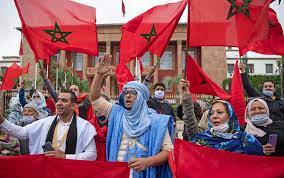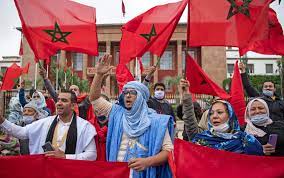INTRODUCTION
This post discusses the political history of morocco, independent Morocco, monarchy, constitution and political parties in Morocco.
HISTORY
The history of human habitation in Morocco spans since the Lower Paleolithic, with the earliest known being Jebel Irhoud. Much later Morocco was part of Iberomaurusian culture, including Taforalt. It dates from the establishment of Mauretania and other ancient Berber kingdoms, to the establishment of the Moroccan state by the Idrisid dynastyfollowed by other Islamic dynasties, through to the colonial and independence periods.
Morocco is a monarchy, and has been ruled by members of the Alaouite dynasty since the beginning of the 17th century. Royal family members claim direct descent from the Prophet Muhammad via his daughter Fatima, his son-in-law Ali Ibn Abu Talib, and their son Hassan. Officially a parliamentary constitutional democracy, in reality Morocco is an authoritarian state where the monarchy wields great political and economic influence. Although the Arab Spring has not arrived in Morocco as yet, calls for fundamental reforms of the political order are strong.
INDEPENDENT MOROCCO (SINCE 1956)
In late 1955, in the middle of what came to be known as the Revolution of the King and the People, Sultan Mohammed V successfully negotiated the gradual restoration of Moroccan independence within a framework of French-Moroccan interdependence. The sultan agreed to institute reforms that would transform Morocco into a constitutional monarchy with a democratic form of government. As the French Foreign Minister Antoine Pinay had expressed, there was a willingness to grant Morocco its independence to “turn Morocco into a modern, democratic and sovereign state”. In February 1956, Morocco acquired limited home rule. Further negotiations for full independence culminated in the French-Moroccan Agreement signed in Paris on 22 March 1956.
Read: Political History Of Senatorial Zones In Nigeria
On 7 April 1956, France officially relinquished its protectorate in Morocco. The internationalized city of Tangier was reintegrated with the signing of the Tangier Protocol on 29 October 1956. the abolition of the Spanish protectorate and the recognition of Moroccan independence by Spain were negotiated separately and made final in the Joint Declaration of April 1956. through this agreement with Spain in 1956 and another in 1958, Moroccan control over certain Spanish-ruled areas was restored. Attempts to claim other Spanish possessions through military action were less successful.
In the months that followed independence, Mohammed V proceeded to build a modern governmental structure under a constitutional monarchy in which the sultan would exercise an active political role. He acted cautiously, intent on preventing the Istiqlal from consolidating its control and establishing a one-party state. He assumed the monarchy on 11 August 1957, and from that date, the country officially became known as ‘The Kingdom of Morocco.
THE MONARCHY OF MOROCCO
Each of Morocco’s first five constitutions since independence began the same way: ‘Morocco is a constitutional democratic and social monarchy.’ The sixth constitution in 2011b added the word ‘parliamentary’: ‘Le Maroc est une monarchie constitutionnelle, démocratique, parlementaire et sociale.’ The monarchy is very old: the current dynasty dates back to the mid-17th century and is the oldest surviving ruling family in the Arab countries.
THE CONSTITUTION
The Constitution is a product of modern nationalism and the struggle for independence, yet there was an early project for constitutional rule in 1908, on the eve of the Protectorate, which proposed limited controls on the sultan and was based on the idea that the Japanese, equipped with a constitution, had defeated the autocratic Russian empire in 1906. This was a common model for early opponents of European imperialism in Africa and Asia.
Constitutionality has a legitimizing role in Morocco, but so does monarchy. As all the constitutions make clear, the head of state is the King (or Sultan, in 1908) who is ‘Commander of the Faithful’ (amir al-muminin). His authority is derived from his role as the political head of a community defined by belief. That authority, Baraka, is an inherited quality passed by genealogical descent from the founder of the Alaouite dynasty Moulay al-Cherif and his son Moulay al-Rashid (1666-1672), who seized power when the Saadi dynasty disintegrated in half a century of civil war.
The French did, however, maintain the institution of royal family and appointed another brother, Yusef, as sultan. When he died in 1927, he was succeeded by his son Mohammed V, who became the symbolic rallying point for a modern nationalist movement that asserted his legitimacy while trying to limit his powers. In the end, the sultan, after changing his title to ‘King’ in 1956, won the post-independence struggle for power.
Mohammed V’s son, Hassan II, who ruled from 1961 until 1999, maintained the facade of a constitutional monarchy, but he was the master of his realm.
He used his constitutional power to appoint the Prime Minister (the leader of the largest party) and to approve and promulgate laws vigorously, repeatedly dissolved Parliament, rewrote the constitution several times, and rigged elections in favor of his supporters.
Parliament and political parties were reduced to marginal roles, and there were severe constraints on the media. The judicial system was subjected to interference by the authorities in political cases, and dissidents were arrested, held incommunicado for long periods, and tortured.
But individuals did not, in the end, ‘disappear’, and the repression was focused, not generalized. The form of a constitutional monarchy was retained, and, towards the end of Hassan II’s reign and after the succession of his son Mohammed VI in 1999, the repression was eased.
The 2011 Constitution, which was immediately the result of the Arab Spring movement, was the long-term consequence of this liberalizing trend. Yet despite its relatively progressive orientation, the new Constitution maintains the monarch as the most important political actor, with his formal rights and legitimacy unchanged.
But Mohammed VI, who came to the throne when he was quite young – he was born in 1963 – has modernizing and technocratic credentials. He earned a BA in law at Rabat-Agdal University and a PhD in law from the University of Nice Sophia Antipolis, where he wrote his thesis on EEC-Maghrib relations. He also spent time training in the office of Jacques Delors, when Delors was President of the European Commission.

POLITICAL PARTIES
The first political parties were founded during the Protectorate, before World War II. Some were Moroccan branches of French political parties based in the settler community, others were specifically Moroccan organizations. The Communist Party was legalized in 1937 and grew through the trade unions.
Because the decree legalizing unions did not explicitly forbid Moroccan workers from joining, the unions began to recruit Moroccans, until the Protectorate administration issued another decree forbidding it. After the protests against the Berber Dahir in 1930, the first Moroccan nationalist groups were set up, and three young leaders became the founding fathers of Moroccan politics, Allal al-Fassi, Mehdi Ben Barka, and Mohammed Hassan Ouezzani.
Al-Fassi, Ouezzani, and others set up the National Action Bloc (Bloc d’Action National, BAN) and proposed a Plan of Reforms in 1934, which the French rejected. The Bloc was banned in 1937 and replaced by two parties, one headed by Ouezzani and the other by al-Fassi.
There was a great rivalry between the two. The parties vanished during World War II but re-emerged after the American invasion of 1943, with the foundation of the Independence Party (Parti de l’Independence, Parti Istiqlal, or Istiqlal, PI), whose manifesto marks the beginning of modern nationalism and the modern Moroccan state.
Istiqlal was initially a grand coalition, but Ouezzani broke away to found the Democratic Independence Party (Parti Democratique et de l’Independence; PDI) in 1946, the same year that Ali Yata became the first Moroccan to lead the Communist Party of Morocco (Parti Communiste du Maroc, PC).
Istiqlal split again in 1957, when Mahjoubi Aherdane and Abdelkarim al-Khatib set up a Berber-dominated, royalist party, the Popular Movement (Mouvement Populaire, MP), and yet again in 1959, when Mehdi Ben Barka led the left wing away to form the National Union of Popular Forces (Union Nationale des Forces Populaires, UNFP; called Socialist Union of Popular Forces or the Union Socialist des Forces Populaires, USFP from 1974).
The Communist Party was banned in 1952 but resurrected in 1974, still with Ali Yata at its head, as the Party of Progress and Socialism (Parti du Progrès et Socialisme, PPS). These historic nationalist parties still exist, though the PDI won no legislative seats since 2002.
A second generation of parties was founded between the late 1960s and early 1980s, the most repressive period of Hassan II’s rule. The King used the parties as a way to divide the political forces. As a result, many were muted in their criticism and positioned themselves in the political centre. They included the National Rally of Independents (Rassemblement National des Indépendants, RNI;
1978), which backed away later from uncritical support of the King; the National Democratic Party (Parti National Démocratique PND; 1981), a centre-right party that split from the RNI; the Constitutional Union (Union Constitutionelle, UC; 1983), a centre-right party claiming to represent the post-independence generation; the Action Party (Parti de l’Action, PA; 1974), a Berber modernist party; and the Popular National Movement (Mouvement National Populaire, MNP; 1991), a centrist offshoot of the MP, led by one of its former leaders, Mahjoubi Aherdane.
The other historic leader of the MP, Abdelkarim al-Khatib, founded the Popular Democratic and Constitutional Movement (Mouvement Populaire Constitutionel Démocratique, MPCD; 1967), which adopted an Islamist tone. Thus, not all the new parties were entirely supportive of the regime: on the left, former members of the USFP and PPS set up the Organization for Democratic and Popular Action (Organisation de l’Action Démocratique et Populaire, OADP) in May 1983.


